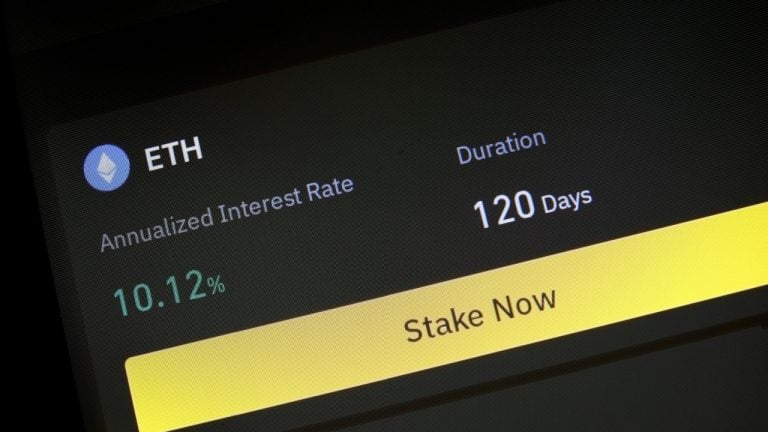 In the first quarter of 2024, approximately $43.8 billion, or 76% of the decentralized finance yield market, earned an annual percentage yield (APY) of about 5% in very low-risk contracts. Staking played a crucial role in the resurgence of decentralized finance, bolstered by the Ethereum network’s transition to a Proof-of-Stake model. The bridging sector experienced […]
In the first quarter of 2024, approximately $43.8 billion, or 76% of the decentralized finance yield market, earned an annual percentage yield (APY) of about 5% in very low-risk contracts. Staking played a crucial role in the resurgence of decentralized finance, bolstered by the Ethereum network’s transition to a Proof-of-Stake model. The bridging sector experienced […]

The average APR offered by blockchain credit protocols is 9.65% compared to an average personal loan interest rate of 11.5%, data shows.
Blockchain-based lending is regaining momentum this year, with the value of active tokenized private credit now sitting at $582 million — a staggering 128% increase from a year ago.
While still far off from its peak of $1.5 billion in June 2022, according to data from real-world asset loan tracker RWA.xyz, the resurgence could signal that loan-seekers are looking for blockchain-based alternatives to traditional financiers amid a recent rise in interest rates.
The current average percentage rate is 9.64% for blockchain-based credit protocols, while financiers have been offering small business bank loan interest rates between 5.75% and 11.91%, according to a Dec. 1 report by NerdWallet.

An increase in staked ETH, lucrative yield on liquid staked ETH tokens and deflationary tokenomics are possible bullish factors for Ether’s price.
The shift of the Ethereum blockchain to a proof-of-stake (PoS) protocol opened new opportunities for developers and investors to explore, including the burning of Ether (ETH). Now, Ethereum transactions are validated through staking rather than mining.
Staking impacts the supply and price dynamics of Ether in ways that are different than mining. Staking is expected to create deflationary pressure on Ether, as opposed to mining, which induces inflationary pressure.
The increase in the total amount of funds locked in Ethereum contracts could also push ETH’s price up in the long term, as it affects one of the fundamental forces that determine its price: supply.
The percentage of newly issued Ether versus burned Ether has increased by 1,164.06 ETH since the Merge. This means that since the Merge, almost all the newly minted supply has been burned through the new burn mechanism, which is expected to turn deflationary when the network sees an uptick in use.
According to Bitwise analyst Anais Rachel, “It's likely that all ETH issued since The Merge will have been taken out of circulation by the end of this week.”
1/ It's likely that all ETH issued since The Merge will have been taken out of circulation by the end of this week pic.twitter.com/WqRASUwi4i
— Anais Rachel (@Anais_Rchl) October 27, 2022
While the graph covers the 43 days since the Ethereum Merge, the tokenomics are set up to turn Ether deflationary.
The reduction is attributable to Ethereum’s movement from proof-of-work to proof-of-stake. The total supply difference shows that Ether is still inflationary, with +1,376 ETH minted since the Merge.

Ankit Bhatia, CEO of Sapien Network, explained to Cointelegraph how staking impacts supply back in May 2020:
“The retail market would most likely acquire ETH from exchanges like Coinbase, which will probably offer the option for buyers to immediately stake their purchase and further reduce circulating supply.”
There is evidence of an increase in locked Ether. For example, DefiLlama shows that over $31.78 billion worth of Ether is currently locked in smart contracts.

In addition to Ethereum’s PoS-locked tokens, Token Terminal data provides a breakdown of staked tokens throughout the Ethereum ecosystem.

The leading protocols include Uniswap, Curve, Aave, Lido and MakerDao. For example, the total value locked (TVL) on Lido is $6.8 billion, while MakerDao has $8 billion.
Showing an increased interest in proof-of-stake, Ether holders depositing to stake are moving Lido to new heights. Lido’s TVL increased from $4.52 billion before the Merge news on July 13 to $6.8 billion at the time of writing.

As October comes to an end, the TVL continues to increase as many investors lock Ether.
The TVL and daily active users (DAUs) of Uniswap have been increasing over time. In most cases, the rise in a protocol’s TVL is accompanied by increases in DAUs on the platform. The most likely cause of the increase in TVL and DAUs is the lucrative Ether staking rewards.

An increase in DAUs at Uniswap may trigger more Ether to burn due to an increase in transactions, and it may also help take more Ether out of circulation as Uniswap’s TVL grows. The top pairing on Uniswap with Ether is USD Coin (USDC), which currently provides a 34-plus percent annual percentage yield.

Ether paired with stablecoins on Uniswap is a top choice for liquidity providers. The pairing is generating, at most, 72.20% APY when looking at Ether paired with Tether (USDT).
It is worth noting that some staking platforms deal with liquid staking derivatives, including Coinbase, Lido and Frax. In such cases, the yield is as high as 7% per year.
Data from EthereumPrice.org shows that Lido pays 3.9% APY, Everstake 4.05%, Kraken 7% and Binance 7.8%.
It is important to note that the rate of return also varies based on the amount invested. Usually, smaller amounts have higher APYs than larger amounts. The yield also depends on the protocol.
For example, validators earn more than those who invest on crypto exchanges and pooled staking. However, validators are required to stake 32 ETH and constantly maintain their nodes, which is a reason platforms like Lido help smaller ETH holders earn.
The increase in Ethereum’s TVL from increased yields, the move to PoS, and DAUs on the top Ethereum decentralized applications could eventually lead to an Ether rally.
The views and opinions expressed here are solely those of the author and do not necessarily reflect the views of Cointelegraph.com. Every investment and trading move involves risk, you should conduct your own research when making a decision.

The key difference between APY and APR is compound interest. Before investing, compare their potential returns.
The APY provides a clear idea of an account’s earning potential. The APR shows what will be owed. Both are calculated over a single year, which provides a more accurate picture than calculating the interest rate alone.
Because the APR is calculated at an annual rate, it can be more advantageous for borrowers seeking the best rates, instead of investing in crypto assets and hoping for a return.
However, because the APY is based on an annualized rate that includes compounding earnings, it's more beneficial for investing crypto assets—it provides a more accurate representation of what will be earned when money is invested and compound interest kicks in.
Understanding whether profits or payments are based on an APR or an APY is crucial when investing or borrowing. Given the nature of the crypto market, returns are often high compared to the traditional finance sector but so, too, are the risks.
Purchase a licence for this article. Powered by SharpShark.
Both the APY and the APR are used to calculate interest for crypto investments and loans. However, they are not the same.
The annual percentage yield refers to the amount of interest earned over a year, while the annual percentage rate is the amount that needs to be paid as interest. When comparing the APR and APY returns, considering that all other factors such as the principal amount, interest rate and period of investment are the same, the key difference is the compound interest.
It represents the total return, including the amount earned on the interest and principal investment. Because the APR does not account for compound interest, the APY always yields a larger sum.
Crypto investors can fund liquidity pools on exchanges, keep crypto in savings accounts, stake their coins or invest in yield farms. The difference between the APY and the APR is crucial to understanding where money is best invested. Practically speaking, APRs are advantageous to borrowers. However, individuals wishing to invest funds should consider APY rates to maximize their profits.
Given that more DeFi tools and cryptocurrencies use APRs, investors have to do manual compounding, where they have to reinvest their gains, either daily or weekly, to get a more significant compound interest.
The compound interest can be set to daily, weekly, monthly, annually or continually.
Calculating the APY is a bit more complex than the APR since interest is added to the principal, and then the interest on that total is calculated, considering the number of periods the amount is adjusted.

To calculate the APY, you can use the following formula:

For example, an investment of 1,000 coins is made at a compound interest of 10% and daily compounding. The following calculation indicates that a total of 1,105 will be collected after one year. In the following year, it should be 1,221. The earnings increase the longer it is held and at higher interest rates.
Every time the computation is updated, the interest should be added to the sum comprising the initial investment and the accrued interest profits. But what does a 10% APY mean in crypto?
Most cryptocurrency projects offer only 1% APY, but some offer 7% on flexible accounts, such as Phemex for Tether (USDT). In the case of fixed saving accounts, they can go as high as 10%. There are also DeFi platforms like PancakeSwap (CAKE) and SushiSwap (SUSHI), which are said to offer very high APYs of over 100% to investors.
The APY, short for Annual Percentage Yield, is a way to measure how much money can be earned on an interest-bearing account in a year. In crypto, the APY is the rate of return made on an investment.
Unlike the APR, which only considers ordinary interest, the APY includes compound interest. Compound interest is the amount earned on the interest and the principal investment. This is why the APY is more profitable than the APR.
Investors can earn an APY by staking their coins and using yield farming to supply liquidity to liquidity pools. They can also earn an APY from holding their coins in savings accounts.
Investors can use crypto exchanges, crypto wallets or DeFi protocols to start earning an APY on their Bitcoin. Interest is often paid in the same cryptocurrency invested; however, there are instances where a different currency is paid.
Here’s how to calculate the total final amount based on APR:

Following the earlier example, this would go as follows:

The calculation changes if the investment is retained for a shorter period. For example, holding for three months is equivalent to a quarter of a year (0.25), which means the calculation will be:

Holding for three months will earn only 1.06 Ether on top of the initial investment. Another formula to calculate APR is:

So, what does a 10% APR mean in crypto?
A 10% APR means 10% is earned on the initial investment after a year.
Using the above calculations, an investment of 10,000 coins at a 10% APR will accrue 1,000 coins in interest after a year.
In cryptocurrency, the APR is the percentage investors can expect to earn as interest on their investment, for lending their crypto or making it available for loans. It considers other fees a borrower needs to pay but does not include compound interest.
Essentially, the APR is the ordinary interest rate applied to the principal amount of an investment or loan. Since the APR is an annualized rate, prorated interest will be charged if an investment or loan is held for a shorter period. For instance, a six-month investment with a 5% APR will yield only 2.5% of the principal amount.
The APR is very straightforward. Take, for example, an investment of 1.0 Ether (ETH) in a lending pool on a decentralized finance (DeFi) network. If the expressed APR is 24%, then 0.24 Ether should be earned on top of the initial investment if it is locked in the pool for exactly one year. As a result, the investment should now total 1.24 Ether, made up of the 1.0 Ether principal and the accrued 0.24 Ether in interest (based on 24 % APR).
According to the Consumer Financial Protection Bureau (CFPB), the APR or annual percentage rate is the amount paid to borrow money. It’s also known as a credit card interest rate and is generated yearly.
For instance, if the APR is 5%, a $100 investment will provide a $5 return a year later. In contrast, if $100 is borrowed at the same interest rate, the initial $100 loan plus $5 in interest must be repaid after a year.
Understanding APR provides an overview of how much will be owed when borrowing money or how much an investor will get paid. In the context of credit cards, APR is typically not charged when the card is used, but the balance is paid each month by the due date. However, if there is an outstanding balance and the due date passes, the interest is added at the end of each billing period.
 Following the governance vote that aimed to implement a semi-dynamic earn rate for the Anchor Protocol, the decentralized finance (defi) platform’s earn rate adjusted downward for the first time this month. After holding steady with a 19.4% annual percentage yield (APY) since the project started, Anchor Protocol’s earn rate is now roughly 18% APY for […]
Following the governance vote that aimed to implement a semi-dynamic earn rate for the Anchor Protocol, the decentralized finance (defi) platform’s earn rate adjusted downward for the first time this month. After holding steady with a 19.4% annual percentage yield (APY) since the project started, Anchor Protocol’s earn rate is now roughly 18% APY for […] On March 23, the cryptocurrency exchange Coinbase announced the platform will now allow cardano staking services. The company’s senior product manager Rupmalini Sahu mentioned that cardano is one of the top ten crypto assets by market cap and its proof-of-stake (PoS) blockchain “seeks to be more flexible, sustainable, and scalable.” Coinbase Now Offers Cardano Staking […]
On March 23, the cryptocurrency exchange Coinbase announced the platform will now allow cardano staking services. The company’s senior product manager Rupmalini Sahu mentioned that cardano is one of the top ten crypto assets by market cap and its proof-of-stake (PoS) blockchain “seeks to be more flexible, sustainable, and scalable.” Coinbase Now Offers Cardano Staking […] While the decentralized finance (defi) platform Anchor Protocol’s native digital asset ANC has gained more than 180% over the last month, the total value locked (TVL) in Anchor has increased a great deal during that time as well. Anchor Protocol is currently the second-largest defi lending platform in terms of TVL, and over the last […]
While the decentralized finance (defi) platform Anchor Protocol’s native digital asset ANC has gained more than 180% over the last month, the total value locked (TVL) in Anchor has increased a great deal during that time as well. Anchor Protocol is currently the second-largest defi lending platform in terms of TVL, and over the last […]
Shark Tank investor Kevin O’Leary says he’s optimistic about Coinbase’s long-term potential despite the considerable drop in the company’s stock price. In an interview with CNBC’s Halftime Report, O’Leary notes that while pressure from regulators stifled Coinbase’s plans to offer yields on the USD Coin (USDC) stablecoin in the US, the crypto exchange’s Lend product […]
The post Shark Tank Star Kevin O’Leary Bullish on Coinbase Despite Heavy Correction of Crypto Exchange’s Stock – Here’s Why appeared first on The Daily Hodl.
 Decentralized finance (defi) has seen extreme demand and innovative use-cases during the last 12 months. Defi oracles, decentralized exchange (dex) platforms and automated money makers (AMM) have swelled in value, as statistics show over $43 billion is locked into defi protocols today. Meanwhile, a new project has recently stepped out of the gate called XFai, […]
Decentralized finance (defi) has seen extreme demand and innovative use-cases during the last 12 months. Defi oracles, decentralized exchange (dex) platforms and automated money makers (AMM) have swelled in value, as statistics show over $43 billion is locked into defi protocols today. Meanwhile, a new project has recently stepped out of the gate called XFai, […]